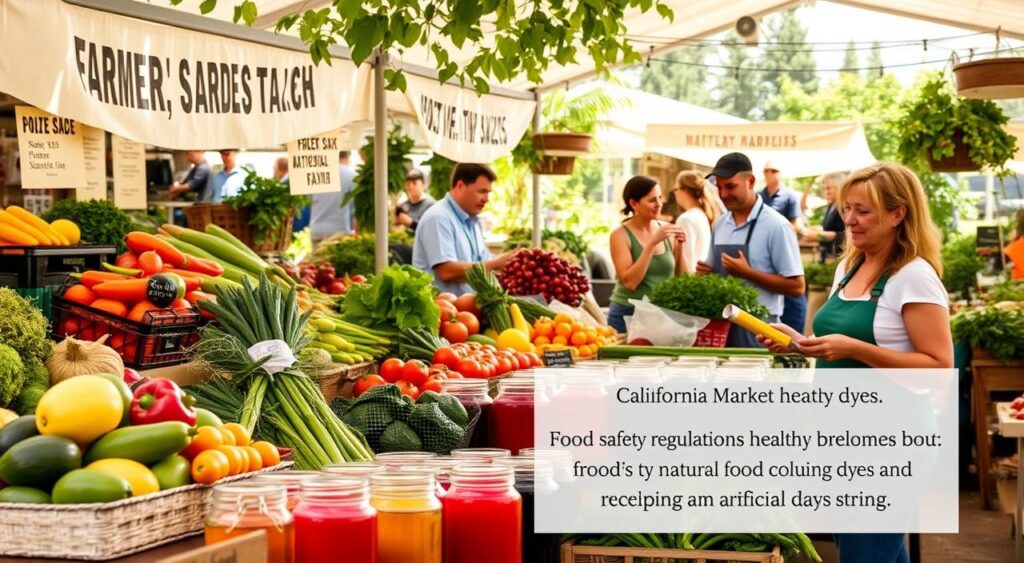California has the biggest public school system in the country. It has over 6.3 million students and 10,000 schools. The state is making a big move to keep everyone safe by banning some food dyes. This is because these dyes can be harmful, especially to kids.
The ban on food dyes is because of worries about their health risks. It’s important to know how this ban affects food makers and buyers. This ban is a big deal for understanding food dye rules in California banning food dyes and the dangers of these dyes.
Key Takeaways
- California has banned certain food dyes due to their potential health risks, which is a key aspect of california banning food dyes.
- The ban aims to protect consumers, especially children, from the harmful effects of these dyes, highlighting the importance of understanding health risks of food dyes.
- The state’s action is a significant step towards ensuring public health and safety, and it is essential to understand the details of the ban and its impact on food manufacturers and consumers, which is closely related to food dye regulation california.
- The ban will be enforced starting on December 31, 2027, giving manufacturers time to reformulate their recipes.
- At least 10 other states have introduced legislation similar to California, indicating a potential national trend towards banning certain food dyes.
- Several top brands have voluntarily removed the banned additives from their products.
Understanding California’s New Food Dye Ban
California’s new food dye ban aims to protect consumers from harmful food dyes. It bans certain dyes and sets a timeline for implementation. It also affects specific food products.
The law will change the food industry, especially in California. It bans dyes like Red Dye 40, Yellow 5, and Yellow 6. These dyes have been linked to behavioral issues in kids. Manufacturers will need to find new colors that meet the regulations.
Key Components of the Legislation
The ban will start in 2028. It will affect school snacks, candies, and baked goods. These items can no longer have certain artificial colorings.
Affected Food Products
The ban will impact the food industry a lot. It will affect products with artificial colorings. Some of these products include:
- School snacks
- Candies
- Baked goods
Food manufacturers will need to find new colors. This will help reduce risks from artificial dyes.
The Science Behind Food Dyes and Their Health Risks
Food dyes have been linked to health issues like hyperactivity, cancer, and neurobehavioral problems. The science behind them is complex. It’s important to know the risks to make smart food choices. California banning food dyes now requires a warning label on foods with synthetic dyes that could cause cancer and other health issues.
The effects of food dyes on health are a big worry, especially for kids. Some studies show a link between artificial dyes and hyperactivity, especially in kids with ADHD. The American Academy of Pediatrics warns about the link between food dyes and ADHD in children. They suggest kids should avoid synthetic dyes. California’s food safety rules aim to reduce these risks by controlling artificial dye use in foods.
The dangers of food dyes go beyond just hyperactivity and ADHD. Long-term exposure to artificial dyes can be toxic, harming organs like the liver and kidneys. Some artificial dyes might even cause cancer, based on animal studies. To address these concerns, some companies are switching to natural dyes. This has led to a 50% increase in natural food coloring use in various products.
| Food Dye | Health Risk |
|---|---|
| Red 40 | Hyperactivity, cancer |
| Yellow 5 and 6 | Hyperactivity, skin rashes |
| Blue 1 | Neurobehavioral problems |
Which Food Colorings Are Being Banned in California
California has banned certain food dyes, like Red Dye 40, Yellow 5 and 6, and Blue 1. This is because of health concerns and the need for stricter rules. The laws aim to protect people, especially kids, from these synthetic dyes’ harmful effects.
The banned food colorings are:
- Red Dye 40, found in foods like Cheetos and Doritos
- Yellow 5 and 6, used in Skittles and M&Ms
- Blue 1, found in Gatorade and Mountain Dew
These dyes might cause behavioral issues and lower attention in kids. This shows the need for stricter rules in California banning food dyes.
The new laws will affect the food industry a lot. Many will have to change their products to meet the new standards. This change is part of a bigger effort to make food safer and protect health, especially from harmful food colorings.
| Food Coloring | Common Uses | Reason for Ban |
|---|---|---|
| Red Dye 40 | Cheetos, Doritos | Potential health risks |
| Yellow 5 and 6 | Skittles, M&Ms | Link to behavioral difficulties |
| Blue 1 | Gatorade, Mountain Dew | Potential health risks |
Impact on Food Manufacturers and Retailers
The ban on food dyes in California will greatly affect companies like Kellanova, Nestlé, and General Mills. They will have to follow new rules and face financial challenges. Consumers have been worried about the health effects of food dyes, leading to a push for natural alternatives. This has shaped the regulations in the California banning food dyes industry.
Companies like Ingredion Inc. are already moving to natural ingredients. They offer plant-based options like corn, potato, and tapioca. This change shows a bigger trend. More people want healthy food, pushing companies to change or lose customers.
Food makers can use natural dyes like beet extract, turmeric, spirulina, and carrot juice. By changing their products, companies can attract health-focused buyers. This can help them grow and stay ahead.

The rules for the California banning food dyes industry will keep changing. There might be more bans on food dyes and closer checks on artificial ingredients. As the ban’s effects grow, companies must focus on following rules, being creative, and making customers happy. This is key to staying competitive.
Natural Alternatives to Artificial Food Dyes
California’s food dye restrictions have led to a shift towards natural colorings. Beet juice and turmeric are now used to create colors without the health risks of artificial dyes. This change is driven by the state’s food dye regulations.
Some examples of natural food colorings include:
- Beet juice, which can be used to create a range of pink to red colors
- Turmeric, which can be used to create a yellow color
- Spirulina, which can be used to create a blue color
These natural colorings are used in many food products. They help manufacturers meet California’s food dye restrictions.
The move to natural colorings is also driven by consumer demand. People want healthier and more sustainable food options. As they learn about artificial dye risks, they look for products with natural colorings.
Food makers who use natural colorings meet California’s rules and appeal to health-conscious buyers.
How This Ban Affects Your Daily Food Choices
California’s food safety rules are changing, and it’s key to know how food dye bans affect our daily choices. Some food coloring is now banned in California. This means we need to check what’s in our food. It’s vital to make smart choices when we shop for groceries.
When you read food labels, look for artificial dyes like Red 40, Yellow 5 and 6, and Blue 1. These are often found in processed foods. Studies show that these dyes can cause hyperactivity and other problems in kids. Here are some tips for better choices:
- Go for foods with natural ingredients and less processing.
- Stay away from foods with artificial dyes, especially those that can harm health.
- Choose products with “USDA Organic” or “Non-GMO Project Verified” labels.
By paying attention to what’s in our food and following California’s rules, we can avoid harmful substances. This helps us live healthier. The ban on food dyes is changing the food world. It’s important to keep up with new info and studies.

| Food Product | Artificial Food Dyes | Natural Alternatives |
|---|---|---|
| Cereal | Red 40, Yellow 5 and 6 | Beet juice, turmeric |
| Ice Cream | Blue 1, Yellow 5 and 6 | Spirulina, annatto |
Health Benefits of Eliminating Artificial Food Dyes
Getting rid of artificial food dyes can help a lot. It can lower the chance of hyperactivity, cancer, and brain problems. For years, people have worried about the health effects of these dyes. California banning food dyes has started to make rules to help fix this.
These rules are getting stricter, which is good for everyone’s health.
Some big benefits of avoiding artificial dyes include:
- Less chance of ADHD and hyperactivity
- Lower risk of cancer and other diseases
- Healthier overall life
The new rules in California banning food dyes are changing the food world. Many companies are now making their products safer. This is a big win for public health.
Removing artificial dyes is a big win for health. California’s rules are a big step towards this goal.
| Food Dye | Health Effects |
|---|---|
| Red 40 | Hyperactivity, cancer |
| Yellow 5 and 6 | Neurobehavioral problems, cancer |
| Blue 1 | Hyperactivity, ADHD |
Comparing California’s Ban to Other Global Regulations
California’s ban on certain food dyes is part of a global movement. The laws in California banning food dyes are being watched by other states and countries. This ban is strict, aiming to protect public health.
The European Union has its own rules for food dyes, focusing on safety. Two-thirds of consumers want ‘clean label’ foods. In contrast, the U.S. allows over 10,000 chemicals in food, while the European Union only allows around 300.
Other U.S. states are also regulating food dyes. Some are proposing laws to ban more additives. The demand for natural colors is growing, pushing suppliers to offer more options. It’s interesting to see how California’s ban will shape the industry.
| Region | Food Dye Regulations |
|---|---|
| California | Bans certain food dyes, including Red 40 and Yellow 5 |
| European Union | Has a comprehensive approach to food safety, with stricter regulations on food dyes |
| U.S. | Allows over 10,000 chemicals in food, color additives, or ingredients |
Comparing California’s ban to global regulations shows the need for a unified approach. As consumers learn more about food dye risks, demand for natural products will grow. This will push the industry towards a healthier future.
Implementation Challenges and Solutions
California is getting ready to ban certain food dyes, and the food industry is facing big challenges. Food makers will have to change their recipes, which takes time and money. Stores will also have to check their products to make sure they meet the new rules.
Removing banned additives like red dye No. 3 and others will be a big task for food companies. These additives are banned in places like Australia and Europe. Food companies will also have to clearly list what’s in their products.
To tackle these issues, food companies can start by checking their recipes for banned ingredients. They might use natural dyes instead of artificial ones. This could save money and be better for the environment. They can also get help from experts to make sure they follow the rules.
The new law gives food companies time to make changes and remove banned additives. This could make people trust food companies more, leading to more sales. Working with regulators and industry groups can help food companies adjust smoothly to the new rules.
What Food Manufacturers Are Doing to Adapt
As California’s food dye regulations kick in, food makers are making big changes. They’re switching to natural dyes instead of synthetic ones. This keeps their products looking good while following the new laws.
They’re also talking to their customers about these changes. This is done through labels, ads, and more. By being open, companies can earn trust and show they’re serious about following the rules.
Some are even looking into new ingredients and ways to make food. For instance, they might use beet juice or turmeric for color. This not only meets the new laws but also lets them create new, appealing products.
| Company | Product | Reformulation |
|---|---|---|
| Just Born | Peanut Chews | Replaced synthetic dyes with natural alternatives |
| General Mills | Fruit Snacks | Introduced new products with natural ingredients |

Food makers are leading the way in adapting to California’s new dye laws. Their efforts will likely make the industry better. As they keep innovating, we’ll see more natural and sustainable food choices in stores.
Impact on Restaurants and Food Service Industry
California banning food dyes industry is changing, and so are the rules for restaurants and food services. They must now follow new rules about food dyes. This means they need to make sure they’re following the law to avoid fines.
The new rules will change how restaurants make their food. They’ll have to change their menus and what they use in cooking. This is because some food dyes are no longer allowed. They’ll have to find new ways to add color to their dishes that are safe and legal.
Here are some important things for restaurants to do:
- Check their ingredients to see if they have banned dyes
- Use natural colors instead of banned ones
- Update their menus and packaging to show the changes
By doing these things, restaurants can follow the new rules. They can also keep their customers happy and trust them.
Children and Food Dyes: Special Considerations
As a parent, knowing about food dyes and their impact on kids is key. California has banned some dyes in schools to protect children’s health. Starting December 31, 2027, schools will not serve foods with Red 40 and Yellow 5.
Here are some important points to consider for kids and food dyes:
- Some kids might get hyperactive or have other brain problems from synthetic dyes, a California EPA report says.
- About 90% of candies, snacks, and drinks for kids in stores have artificial dyes.
- The FDA says Yellow 5 is safe, but studies show it can harm young kids’ brains.
Parents need to choose healthy foods for their kids. Knowing about food dyes and following California’s rules can help keep kids safe and healthy.

Economic Impact on California’s Food Industry
The ban on food dyes in California will greatly affect the food industry. Companies will need to make quick changes and adapt to new market trends. As people learn more about the dangers of artificial dyes, they want healthier food options. This means 76% of customers value clear product information.
Companies like Genexa are seeing their sales grow as they offer cleaner products. This change in what people want is pushing companies to reformulate their products. It’s a big shift for the industry.
The ban will also lead to changes in how companies follow regulations. They will need to adjust their supply chains and meet new labeling rules. This might raise costs and cause some losses. But, the long-term health benefits and increased trust from consumers will likely outweigh these costs.
Some important numbers show the ban’s economic effects:
- 8% more sales of clean-label products in the past year
- 80% of Starbucks products needed to be changed to meet new standards
- Possible changes to Medicaid and school lunches in California banning food dyes
Conclusion
California’s ban on artificial food dyes is a big step for public health. It removes harmful dyes like Red Dye 40 and Yellow 5 and 6. This lets people choose better for their families.
This ban could help a lot of people. Studies show these dyes can harm kids’ behavior and focus. With ADHD cases rising, this ban is a timely action.
Changing to natural ingredients might be hard for some businesses. But, it’s good for everyone’s health in the long run. As people want healthier food, companies can make natural products.
California’s move is a big example for others. It shows putting people first is important. This could lead to a future where healthy food is common, not rare.

